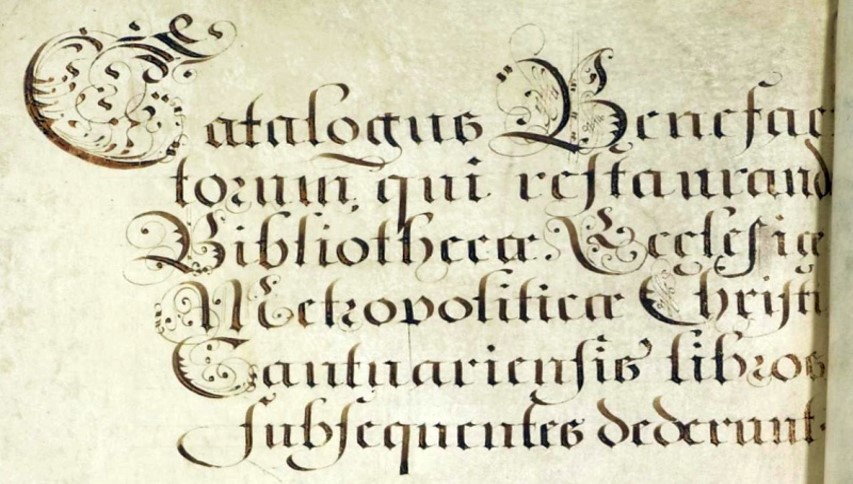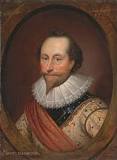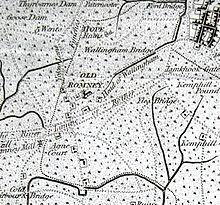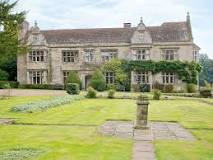An attempt to acquire a book for Canterbury Cathedral Library in 1628
In 1628 Dr Isaac Bargrave, Dean of Canterbury since 1625, proposed to Chapter that the Cathedral’s Library needed reviving. At the June meeting of Chapter, an order was approved for this purpose :
That every man should do his endeavour to refurnish the ancient library of the said church. And that a book of velume should be provided wherein the names of the Benefactors should be registered, and that the two upper most deskes should be instantly fitted for the receipt of such books as shall be first given to the encouragement of so good a work.
(Chapter Acts, CCA DCc-CA/4: 1608–1628, fol. 304v;
transcription from Woodruff and Danks, Memorials of the Cathedral and Priory of Christ in Canterbury, London: 1912, p. 388)

The Benefactors’ Book was duly provided (Canterbury Cathedral Archives Lit.MS E40) and entries of gifts were made in it, presumably by Horton Drayton, the Cathedral’s Auditor and Registrar. The Dean himself gave several books, including a copy of the printed catalogue of the Bodleian Library at Oxford, founded about twenty-five years before by Sir Thomas Bodley (Thomas James, Catalogus vniversalis librorum in Bibliotheca Bodleiana, 1620. Shelfmark W2/A-4-14).
By 1634 when a new inventory of the Cathedral Library’s books was made for Archbishop Laud’s visitation (CCA DCc-LA/1/2: Catalogus librorum qui sunt in Bibliotheca Ecclesiae Cantuariensis), nearly three dozen printed works had been acquired for the Library (92 volumes in all), with gifts from at least ten individuals, including a bequest from the will of Archbishop George Abbot. Most of these books can still be found in the Cathedral Library.
A number of the early benefactors were Cathedral clergy. Alexander Chapman, Archdeacon of Stow and canon of Canterbury, who died in 1629, left 3 volumes in his will. Richard Clerke, one of the Six Preachers (died 1634) gave an eight-volume Bible in Hebrew, Chaldaic, Greek and Latin which he had probably used when he was one of the translators of the Old Testament for the King James Bible.
 Sir Alexander Temple, M.P.
Sir Alexander Temple, M.P.A recently published blog from the Library of New College, Oxford, has an article by John Matthews about Sir Alexander Temple, M.P. (1583–1629) (New College Notes, 11, 2019). It contains a tantalising penultimate paragraph stating that ‘later in his life, Sir Alexander donated a book to the library at Canterbury Cathedral, as a mark of gratitude for a visit to his home by the auditor to settle the details of a lease to his daughter of land owned by the Dean and Chapter.’ If Sir Alexander died in 1629, this donation would be contemporary with Isaac Bargrave’s campaign to replenish the Chapter Library in 1628. There was no reference to the source for this statement about Sir Alexander, his daughter and Horton Drayton the Auditor, but a search on the Cathedral Archives online catalogue quickly found that CCA DCc/CantLet/69, dated 1628, was a letter from Sir Alexander Temple.
 Agney Court, south of Old Romney
Agney Court, south of Old RomneyThis document records that Sir Alexander Temple offered Horton Drayton a book for the Library in connection with the issue of a lease for Temple’s daughter Susanna Thornhurst’s property in Agney, Old Romney, one of the Cathedral’s estates. Temple’s letter to Horton is dated from his house in Haremere, Sussex, on 28 February 1627 but this is probably to be interpreted as February 1628: the contemporary practice of dating the start of the year from Lady Day (25 March) would mean that 28 February 1627 would be 1628 new style.
Temple’s letter asks Drayton to bring the new lease to his house in Haremere and recommends making the trip when Drayton is next going via Ashford: ‘being two small days [journey?] from my house which is with in 2 myles of Robrtsbridg but in one daye you cannot come from Caunterbery to me.’ The letter is endorsed in Drayton’s hand:
Concerning Aghney court
taking downe a barne
promise of a booke to the library
Drayton’s endorsement continues ‘throughe Stone stret to Braburne to Smeed to Newchurch to Ivechurch to Hook house in Brookland to Guilford ferry’. This seems to be the itinerary which he took to deliver the lease to Sir Alexander in Haremere.
 Haremere Hall, near Etchingham
Haremere Hall, near EtchinghamThe endorsement states ‘promise of a booke to the library’, rather than recording the gift of a book. It would seem that the Auditor had extracted such a promise from Sir Alexander while in Haremere, in implementation of the Chapter’s call in June 1628 that ‘every man should do his endeavour to refurnish the ancient library of the said church’. Several examples are known from later in the seventeenth century of lessees giving a book to the Chapter Library on the occasion of the renewal of a lease, but this 1628 example is rather earlier.
However, Sir Alexander is not mentioned in the Benefactors’ Book and the Chapter Library has no book with his donation inscription. It may be that he had died before being able to carry out his promise. The History of Parliament website records that ‘he made his will while “sick in body” on 21 Nov. 1629, instructing his executors to sell his lands to pay his debts. His will was proved on 19 Dec. and he was buried in Rochester Cathedral in the same month.’ The promised book seems never to have materialised.